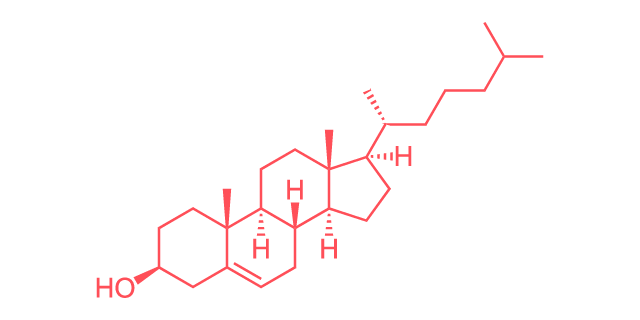Cholesterol

Linear Formula
C27H46O
Synonyms
Cholesterol, Cholesterin, Cholesteryl alcohol, Cholest-5-en-3beta-ol
Share this metabolite
Cholesterol, or cholesterin, is a sterol, steroid, or stearyl alcohol. Sterols contain four fused rings of 17 carbon atoms with a hydroxyl group at position 3 in the A ring. Cholesterol has an additional double bond at the 5,6 position and a simple aliphatic tail of eight carbon atoms. The name of the molecule is of Greek origin with “chole” meaning “bile” and “stereos” meaning “solid,” followed by the suffix “-ol” for “alcohol.”
All animal cells contain cellular membranes consisting of a mixture of long-chain lipids, phospholipids, and sterols. Due to its bulky structure, cholesterol disrupts the fluidity of the lipid membrane, making it more stiff and rigid locally. Here, cholesterol is involved in several essential cellular processes, such as the transport of lipids across the cell membrane, protein and enzyme activity, cell signaling, and intracellular trafficking.1 As such, cholesterol has a wide range of critical functions within the human body, including energy metabolism, hormonal balance, heart health and blood flow, digestion, and brain function.
Accordingly, it is of no surprise that cholesterol is probably the most highly decorated molecule in biology. At least eleven Nobel Prizes were awarded to scientists working on the biological role of cholesterol.2
Production, Uptake, and Transport of Cholesterol
Virtually all animal cells have the capacity to synthesize cholesterol, with the liver and brain producing the largest amounts. Hence, by eating foods of animal origin, we take up cholesterol. Liver and other organ meat contain the highest amounts, followed by egg yolk, shrimp, and whole milk dairy products, such as butter, cream, and cheese.
Once produced in the liver, cholesterol is transported to the gallbladder, where it is secreted into the intestine together with bile acids. Here, the produced cholesterol mixes with cholesterol from food, and both are taken up by intestinal cells. Hence, only 25% of blood cholesterol in humans comes from diet, with the immediate response of the serum cholesterol level to dietary cholesterol being rather small.3
After absorption in the intestines, cholesterol is attached to lipoproteins, which solubilize the amphiphile molecule. These lipoproteins, known as very-low-density lipoprotein and chylomicron, transport triglycerides together with cholesterol in the blood and distribute them within the body. Throughout this transport process, the lipoproteins encounter different cell receptors, which cleave off many of the triglycerides. This leaves the low-density lipoprotein (LDL cholesterol or “bad cholesterol”) and chylomicrons enriched in cholesterol.
The majority of these remnants are then taken up and cleared by the liver. Notably, the high-density lipoprotein (HDL cholesterol or “good cholesterol”) picks up excess cholesterol and transports it back to the liver. Since the liver cannot degrade cholesterol, it either stores excess cholesterol in fatty deposits or converts it into bile acids to secrete them into the intestine. Here, cholesterol and bile acids are either excreted, metabolized by gut microbes and reabsorbed, or reabsorbed together with dietary fats, closing the systemic cholesterol cycle.
Cholesterol and Metabolic Health
Cholesterol is not only an essential structural component of all human cell membranes, but it is also a precursor for several hormones, vitamin D, and bile acids. Hence, optimal cholesterol levels are key for human health, while several metabolic diseases are associated with genetic defects linked to cholesterol metabolism and an altered blood cholesterol level.
All steroid hormones are produced from cholesterol, with their production taking place in various organs and tissues, such as adrenal glands, liver, kidney, placenta, brain, and skin. As such, cholesterol is involved in the synthesis of mineralocorticoids, glucocorticoids, and sex hormones, impacting blood volume, sexual development, salt-water balance, stress, and immune response.4
As a precursor of vitamin D, cholesterol impacts the immune system directly and indirectly. Both vitamin D and cholesterol activate an inflammatory response to clear infections and tumor cells. However, cholesterol also provides activated T-cells with energy for effector functions. Additionally, increased cholesterol levels modify the membrane fluidity of immune T- and B-cells, which is critical for cell signaling and antigen presentation.5
Even though not fully understood yet, recent studies showed that elevated levels of low-density lipoprotein cholesterol are linked to diabetes mellitus. Women seem to be more susceptible to this condition. A high-fat diet can increase the chances of developing diabetes because the increased synthesis of triglycerides in the liver reduces high-density lipoprotein cholesterol levels, which can trigger insulin resistance and a pro-inflammatory state to further the onset of diabetes.6
Cholesterol and the Heart
On their journey through the human body, the large spherical, very low-density lipoproteins and chylomicrons carrying triglycerides and cholesterol encounter cells and interact with their surface-bound lipases. These cleave off fatty acids to import them into the cell, thus lowering triglyceride levels. The lipoprotein remnants become smaller and enriched in cholesterol.7
Due to their smaller size, the lipoprotein remnants can be taken up by macrophages in the arterial wall of blood vessels and smooth muscle cells. Since human cells cannot degrade cholesterol, too much cholesterol can build up under specific circumstances, causing the cells to become disformed, inflamed, and nonfunctional, leaving atherosclerotic plaques with accumulated cholesterol.3
Increasing plaque buildup can block blood flow and even result in serious cardiovascular diseases, such as coronary artery disease, peripheral artery disease, or carotid artery disease. Hence, high levels of bad cholesterol—often the result of an unhealthy diet rich in saturated fats—lead to a higher risk for heart disease, heart attack, and stroke.8 Conversely, high-density lipoprotein is thought to be atheroprotective, which is why it is called good cholesterol.
Cholesterol in the Central Nervous System
Notably, lipoproteins carrying triglycerides and cholesterol cannot cross the blood-brain barrier. Yet, the central nervous system contains 20 to 25% of the total cholesterol found in the body, even though it only makes for about 2% of the total human body weight. Hence, the central nervous system needs to synthesize, transport, store, and excrete cholesterol all on its own.
About 70 to 80% of the cholesterol in the central nervous system resides in myelin, which is the extension of the plasma membrane of neural axons. Accounting for up to 30% of its lipid content, cholesterol stabilizes the membrane, which can thus function as the electrical insulation of axons.
Additionally, 20 to 30% of the cholesterol in the central nervous system is found in the plasma membranes of neurons and glia, often supporting their elaborated morphology. Here, cholesterol is involved in synaptic transmission and other processes.
Hence, cholesterol is also a critical factor in neurological health. An atypical cholesterol metabolism in the central nervous system was shown to be linked to several neurodegenerative diseases, such as Alzheimer’s disease, Parkinson’s disease, amyotrophic lateral sclerosis, and frontotemporal dementia.9
Healthy Cholesterol Levels and Lifestyle Habits
Cholesterol is an essential molecule for the human body, its metabolism, health, and basic functioning. Yet, unhealthy cholesterol levels can lead to serious health problems. Regular lipid profile checks with cholesterol screening for HDL, LDL, and total cholesterol levels via blood test is an important disease screening and prevention strategy for those with relevant family history.
Cholesterol can often be managed by modifying certain lifestyle habits, including diet and exercise. Studies have shown that low salt diets, a healthy diet low in saturated fat (e.g., animal fats) and favoring trans fats, and plant-based diets can help prevent high cholesterol.10 Furthermore, moderate exercise for at least 30 minutes on most days of the week, maintaining adequate body weight, and not smoking all help strengthen the heart muscle, keep HDL levels high, and help avoid plaque buildup.
Genetic makeup could make it more difficult to control cholesterol levels via lifestyle habits, however, and a last resort might be to remove LDL cholesterol from the blood through lipoprotein apheresis.
Cholesterol in Research
As of August 2023, there are over 57,000 citations for “cholesterol” in research publications (*excluding books and documents) on PubMed. The extensive number of publications linking cholesterol to metabolic and cardiovascular health suggests that any studies aiming to better understand cardiovascular disease, metabolic diseases, or altered metabolism in the context of other diseases such as cancer may benefit from quantifying cholesterol.
References
- Chakraborty S, Doktorova M, Molugu TR, et al. How cholesterol stiffens unsaturated lipid membranes. Proc Natl Acad Sci U S A 2020; 117(36):21896-21905.
- Kuijpers P. History in medicine: the story of cholesterol, lipids and cardiology. e-Journal of Cardiology Practice 2021;19(9).
- Blesso CN, Fernandez ML. Dietary Cholesterol, Serum Lipids, and Heart Disease: Are Eggs Working for or Against You? Nutrients 2018;10(4):426.
- Biason-Lauber A, Boscaro M, Mantero F, et al. Defects of steroidogenesis. J Endocrinol Invest 2010;33(10):756-66.
- Cardoso D, Perucha E. Cholesterol metabolism: a new molecular switch to control inflammation. Clin Sci (Lond) 2021;135(11):1389-1408.
- Hu X, Liu Q, Guo X, et al. The role of remnant cholesterol beyond low-density lipoprotein cholesterol in diabetes mellitus. Cardiovasc Diabetol 2022;21(1):117.
- Farnier M, Zeller M, Masson D, et al. Triglycerides and risk of atherosclerotic cardiovascular disease: An update. Arch Cardiovasc Dis 2021;114(2):132-139.
- Balling M, Afzal S, Varbo A, et al. VLDL Cholesterol Accounts for One-Half of the Risk of Myocardial Infarction Associated With apoB-Containing Lipoproteins. J Am Coll Cardiol 2020;76(23):2725-2735.
- Ho WY, Hartmann H, Ling SC. Central nervous system cholesterol metabolism in health and disease. IUBMB Life 2022;74(8):826-841.
- Sandesara PB, Virani SS, Fazio S, et al. The Forgotten Lipids: Triglycerides, Remnant Cholesterol, and Atherosclerotic Cardiovascular Disease Risk. Endocr Rev 2019;40(2):537-557.

